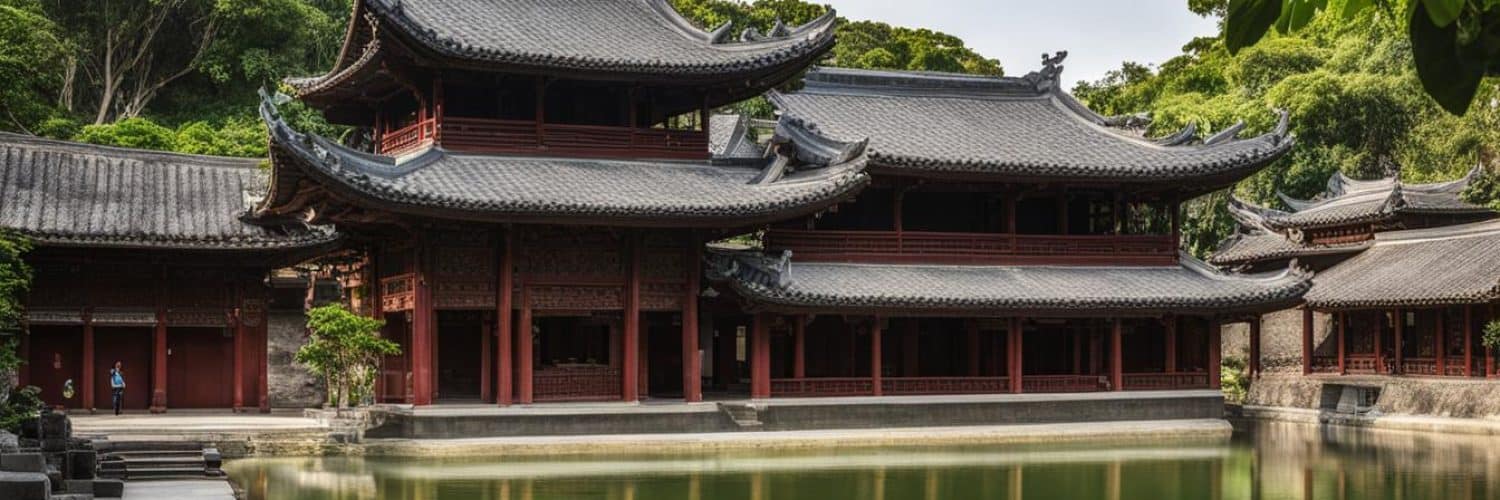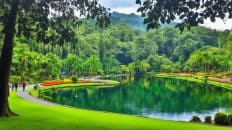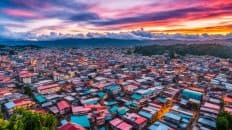Have you ever wondered about the ancient seafaring traditions of the Philippines? Or how a small city in Mindanao played a significant role in Philippine history? If so, prepare to be captivated by the Balanghai Shrine Museum in Butuan City. Discover the cultural heritage and historical treasures that await you in this fascinating museum.
Key Takeaways:
- Experience the rich cultural heritage of Butuan City at the Balanghai Shrine Museum.
- Learn about the ancient watercraft known as Balanghai and its importance in Philippine history.
- Explore the artifacts and archaeological finds that provide insights into the maritime activities and traditions of the ancient Butuanons.
- Witness the preservation efforts and the recognition of the Balanghai Shrine Museum as a National Cultural Treasure.
- Immerse yourself in Butuan’s vibrant past and discover the city’s contributions to Philippine history.
The Importance of the Balanghai Boat
The Balanghai boat holds immense significance in Philippine archaeology and history. This large wooden boat, constructed using plank-building techniques and edge pegging, is made of a hardwood known as Heretiara Litorales. The construction method employed in the making of the Balanghai boat reflects the typical boat-making practices of Southeast Asia.
By studying the Balanghai boat and the cultural relics associated with it, we gain valuable insights into the maritime activities and practices of a prosperous seafaring community in ancient times. The artifacts discovered in and around the boat, including human and animal remains, coffins, pots, jewelries, and hunting goods, offer a glimpse into the cultural and subsistence practices of the ancient Butuanons.
Presidential Recognition
The Balanghai Shrine Museum in Butuan City, Mindanao, holds immense historical and cultural significance. This is evident in its recognition as a National Cultural Treasure by virtue of Presidential Proclamation No. 86, issued on March 9, 1987, during the time of President Corazon C. Aquino.
The prestigious designation of being a National Cultural Treasure highlights the museum’s invaluable contribution to preserving the heritage of Butuan City. It emphasizes the importance of the Balanghai boat and the artifacts associated with it in the broader context of Philippine history and cultural heritage.
By receiving this recognition, the Balanghai Shrine Museum has solidified its position as a significant institution dedicated to safeguarding and showcasing the rich historical and cultural treasures of Butuan City and Mindanao as a whole.
The Establishment of the Balanghai Shrine
The Balanghai Shrine Museum in Butuan City, Mindanao, stands as a testament to the dedication and generosity of Felix A. Luna. In 1979, Luna generously donated the land that allowed the establishment of the shrine, which serves as a vital hub for preserving and showcasing the Balanghai boat and other significant cultural artifacts.
Thanks to Luna’s contribution, the Balanghai Shrine Museum has become a cherished destination for visitors seeking to delve into the rich cultural heritage of Butuan City. The museum’s mission is to ensure the preservation of Butuan’s historical past and to provide future generations with a unique opportunity to connect with their roots.
The commitment of individuals like Luna plays a crucial role in safeguarding the rich history and traditions of Butuan. Their generosity ensures that the Balanghai Shrine Museum remains a beacon of cultural pride and heritage preservation in Mindanao.
| Benefactor | Contribution |
|---|---|
| Felix A. Luna | Donated the land for the establishment of the Balanghai Shrine Museum in 1979 |
Museum Highlights
The Balanghai Shrine Museum in Butuan City, Mindanao, is a treasure trove of ancient artifacts that provide a fascinating glimpse into the region’s rich history. The museum showcases a wide range of archaeological finds, offering visitors a comprehensive experience of Butuan’s ancient past.
One of the main highlights of the museum is the preserved Balanghais, traditional boats that were used by the ancient Butuanons for maritime activities. Inside the museum, visitors can marvel at three excavated Balanghais, each intricately crafted and well-preserved. These boats serve as a testament to the advanced seafaring skills and craftsmanship of the ancient Butuanons.
Additionally, the museum features the original excavation site in Libertad, Butuan, where five Balanghais remain in situ. This provides a unique opportunity for visitors to witness the boats in their original context, surrounded by the historical landscape where they were discovered.
Aside from the Balanghais, the museum also showcases pre-Spanish coffin burials that were unearthed in the area. These coffins, dating back to the 14th-15th century, offer a fascinating insight into the burial practices of the ancient Butuanons. Visitors can explore these pre-Spanish tombs and gain a deeper understanding of the ancient funerary customs in the region.
The Balanghai Shrine Museum further enriches visitors’ understanding of Butuan’s history through its display of various artifacts such as pottery jars, coffins, jewelries, tools, and ceramics. These artifacts provide a comprehensive overview of the region’s cultural practices, trade activities, and artistic achievements.
Intriguing Artifacts at the Balanghai Shrine Museum:
| Artifact | Description |
|---|---|
| 1. Pottery Jars | A collection of intricately designed earthenware jars, showcasing the advanced pottery-making skills of the ancient Butuanons. These jars were used for storage, cooking, and other domestic purposes. |
| 2. Coffins | A display of pre-Spanish coffin burials, giving visitors a glimpse into the burial practices of the ancient Butuanons. The coffins are adorned with intricate carvings and are a testament to the region’s rich funerary traditions. |
| 3. Jewelries | A stunning collection of ancient jewelries crafted from various materials such as gold, precious stones, and shells. These jewelries highlight the remarkable craftsmanship and artistic sensibilities of the ancient Butuanons. |
| 4. Tools | A range of ancient tools used by the Butuanons for farming, fishing, and other daily activities. These tools provide insights into the practical skills and lifestyle of the ancient inhabitants of Butuan. |
| 5. Ceramics | A diverse collection of ceramic artifacts, including intricately designed vases, bowls, and plates. These ceramics showcase the Butuanons’ mastery of pottery and their engagement in trade and cultural exchanges with neighboring regions. |
Visiting the Balanghai Shrine Museum is an immersive experience that allows visitors to delve deep into the ancient history and cultural heritage of Butuan City. Through these remarkable artifacts and excavated Balanghais, visitors can gain a profound appreciation for the rich traditions and achievements of the ancient Butuanons.
Visiting the Balanghai Shrine Museum
When planning your visit to Butuan City in Mindanao, the Balanghai Shrine Museum should be at the top of your itinerary. Located in Libertad, approximately five kilometers from the city center, this museum is a testament to the rich cultural heritage of the region.
To reach the museum, you can easily take a tricycle from the Libertad public market. The short journey will transport you to a world of ancient treasures and historical significance.
The Balanghai Shrine Museum is open from Monday to Friday, welcoming visitors from 8:00 am to 5:00 pm. Admission to the museum is free, allowing everyone to explore its fascinating exhibits and learn about the deep-rooted history of Butuan City.
While there is no entrance fee, donations are greatly appreciated. Your support goes towards the maintenance of the museum and the preservation of its precious artifacts, ensuring future generations can continue to appreciate and learn from Butuan’s cultural heritage.
Preservation Challenges
The preservation of the Balanghai boats and artifacts found in the Balanghai Shrine Museum faces significant challenges, primarily due to the prohibitive costs involved. While the National Museum has successfully excavated and preserved three Balanghais, the remaining five are still in situ, awaiting further preservation efforts. Despite these challenges, the dedicated team at the museum is tirelessly working to protect and showcase these invaluable cultural treasures found in Butuan City.
Unearthing Pre-Spanish Coffin Burials
During the excavation of the Balanghais in Butuan City, Mindanao, an astonishing discovery was made – pre-Spanish coffin burials dating back to the 14th-15th century. These ancient coffins provide valuable insights into the burial practices of the ancient Butuanons and add to the historical and archaeological significance of the Balanghai Shrine Museum.
The pre-Spanish coffin burials unearthed in Butuan City serve as a link to the past, offering a glimpse into the customs and traditions of the ancient inhabitants of Mindanao. These coffins contain bones and skulls, providing tangible evidence of the ancient burial practices that were prevalent in the region.
“The discovery of the pre-Spanish coffin burials underscores the rich cultural heritage of Butuan City and adds to the significance of the Balanghai Shrine Museum as a historical site,” says Dr. Maria Santos, a renowned archaeologist.
These coffin burials are a testament to the reverence and respect the ancient Butuanons had for their departed loved ones. They offer researchers and visitors the opportunity to delve deeper into the ancient funerary customs and gain a better understanding of the cultural practices of the time.
By studying the pre-Spanish coffin burials, archaeologists and historians can piece together a more comprehensive picture of the ancient Butuan society, shedding light on their beliefs, traditions, and way of life. The presence of these burials within the Balanghai Shrine Museum further enhances its role as a keeper of Butuan’s cultural heritage.
Significance of the Pre-Spanish Coffin Burials
The discovery of the pre-Spanish coffin burials is significant as it offers a unique window into the past, allowing us to explore the rich history of Butuan City. These burials are a testament to the vibrant and complex society that once thrived in the region, and they serve as a reminder of the ancient roots from which the modern Butuanon culture has grown.
| Key Findings | Insights |
|---|---|
| Bones and skulls | Provide evidence of pre-Spanish burial practices |
| Funerary artifacts | Offer insights into the customs and rituals associated with burial |
| Excavation sites | Reveal the scope and scale of ancient burial grounds in Butuan City |
| Archaeological analysis | Enables a deeper understanding of the cultural practices of the ancient Butuanons |
The pre-Spanish coffin burials found in Butuan City are a testament to the rich tapestry of history and culture that lies beneath the surface of this remarkable city. They stand as a tangible link to the past and a reminder of the deep-rooted traditions that continue to shape the present-day Butuanon identity.
Historical Significance of Butuan
Butuan City holds a special place in Philippine history. It was one of the ancient settlements in the archipelago and a significant center of trade and commerce during pre-colonial times. The Balanghais and other artifacts found in Butuan showcase the city’s maritime activities and its role as a hub for cultural exchange and trade. Exploring the Balanghai Shrine Museum allows visitors to delve into the rich history of Butuan and its contributions to the development of the Philippines.
| Ancient Settlements in Butuan | Historical Significance |
|---|---|
| 1. Butuan Archaeological Sites | Reveal traces of a prehistoric settlement with artifacts that date back more than 2,000 years. |
| 2. Balanghais and Maritime Activities | Showcase the seafaring traditions and advanced boat-making skills of the ancient Butuanons. |
| 3. Center of Trade and Commerce | Acted as a major trading hub, connecting Butuan with other parts of the Philippines and Southeast Asia. |
The historical significance of Butuan is inextricably linked to its ancient settlements and their contributions to Philippine history. The archaeological sites found in Butuan provide evidence of a thriving civilization that existed long before the arrival of colonizers. The discovery of Balanghais, ancient boats used for trade and transportation, highlights the importance of maritime activities in the region. These boats were not only means of transportation but also vessels of culture, carrying goods, ideas, and traditions across the archipelago.
As a center of trade and commerce, Butuan played a crucial role in linking the Philippines with neighboring regions in Southeast Asia. Through trade, the ancient Butuanons engaged in cultural exchange, further enriching their own society and contributing to the development of the Philippine archipelago. The artifacts excavated in Butuan tell a story of a vibrant and cosmopolitan city that thrived in pre-colonial times.
The Balanghai Shrine Museum serves as a gateway to this fascinating history, offering visitors a glimpse into the ancient settlements, maritime activities, and cultural exchanges that shaped Butuan’s identity. Exploring the museum allows one to appreciate the enduring legacy of Butuan and its immense contributions to Philippine history and heritage.
Butuan’s Cultural Heritage
The Balanghai Shrine Museum in Butuan City, Mindanao, not only houses ancient artifacts but also serves as a testament to the vibrant cultural heritage of the region. By preserving and showcasing these cultural treasures, the museum plays a vital role in promoting cultural preservation, traditional practices, and the seafaring traditions of the ancient Butuanons.
The museum offers visitors a fascinating glimpse into the rich history and customs of the Butuan people. It exhibits traditional craftsmanship, highlighting the skill and artistry of the ancient Butuanons. Through the museum’s displays, visitors can gain a deeper appreciation for the cultural traditions and practices that have shaped the region over centuries.
“The Balanghai Shrine Museum is a treasure trove of Butuan’s cultural heritage, showcasing the ancient seafaring traditions and craftsmanship of the Butuanons.”
Among the highlights of the museum’s collection are the Balanghais, which were integral to the navigation and trade activities of the ancient Butuanons. These exquisite watercraft provide valuable insights into the seafaring skills and maritime history of the region.
In addition to the Balanghais, the museum displays various artifacts, including pottery, jewelry, tools, and ceremonial objects, all of which offer significant glimpses into the cultural practices and beliefs of the Butuanons.
The Balanghai Shrine Museum serves as a platform for cultural preservation and awareness, ensuring that the traditional practices and customs of the ancient Butuanons are celebrated and understood by future generations.
Preserving Butuan’s Cultural Heritage
The commitment to cultural preservation is evident in the efforts of the Balanghai Shrine Museum. Through its exhibits and educational programs, the museum strives to engage visitors in the rich tapestry of Butuan’s cultural heritage.
“By preserving the ancient artifacts and showcasing traditional practices, the Balanghai Shrine Museum plays a vital role in promoting cultural awareness and appreciation in the Butuan region.”
The museum’s dedication to preserving and promoting cultural heritage not only fosters a sense of pride among the local community but also fosters a deeper understanding and appreciation among visitors from around the world.
Discovering Butuan’s Cultural Roots
Visiting the Balanghai Shrine Museum is a captivating journey into the cultural roots of Butuan. As visitors explore the exhibits, they can immerse themselves in the ancient traditions and practices that have shaped the identity of the Butuanons.
The museum’s displays, combined with knowledgeable guides, provide a comprehensive understanding of the cultural significance of Butuan and its role in Philippine history.
By celebrating and preserving Butuan’s cultural heritage, the Balanghai Shrine Museum ensures that the city’s vibrant past is cherished and appreciated by generations to come.
Exploring Butuan City
Beyond the Balanghai Shrine Museum, Butuan City offers a range of other tourist attractions for visitors to explore. From the beautiful Sto Nino Shrine to the bustling Libertad public market, there is something for everyone in Butuan.
Visitors can also embark on a historical tour of the city, visiting sites like the Butuan Museum and the Golden Tara replica. Butuan City is a treasure trove of history and culture waiting to be discovered.
Popular Tourist Attractions in Butuan City:
- Sto Nino Shrine
- Libertad Public Market
- Butuan Museum
- Golden Tara Replica
Explore the vibrant city of Butuan and immerse yourself in its rich heritage, vibrant culture, and fascinating history. Whether you’re interested in visiting historical landmarks or experiencing the local market scene, Butuan has something to offer every traveler.
How to Get to the Balanghai Shrine Museum
Visiting the Balanghai Shrine Museum in Butuan City, Mindanao is a rewarding experience for history enthusiasts and cultural explorers. Here’s a guide on how to get to this remarkable destination:
Directions
To reach the Balanghai Shrine Museum, you can follow these simple directions:
- Start by taking a jeepney bound for Libertad.
- Alight at the corner going to Brgy. Paradise.
- Hire a tricycle or pedicab to reach the museum from there.
Transportation around Butuan City is convenient, with jeepneys and tricycles readily available to take you to different destinations.
Visitors to Butuan City can enjoy a hassle-free journey to the Balanghai Shrine Museum and indulge in the rich historical and cultural heritage it offers.
Opening Hours and Admission
Planning a visit to the Balanghai Shrine Museum in Butuan City, Mindanao? Here’s what you need to know about the museum’s opening hours and admission:
The Balanghai Shrine Museum is open from Monday to Friday, welcoming visitors from 8:00 am to 5:00 pm. Whether you’re an early riser or prefer an afternoon visit, the museum’s extended hours ensure that you have ample time to explore the fascinating exhibits.
Upon your arrival, don’t forget to sign the logbook as a visitor to the museum. This simple step allows the museum to keep track of the number of guests and helps with overall visitor information.
Here’s the best part – admission to the Balanghai Shrine Museum is absolutely free! You have the opportunity to immerse yourself in the rich cultural heritage of Butuan City without any entrance fee. However, the museum greatly appreciates any donations you may wish to give. Your generosity goes towards the maintenance of the museum and its precious exhibits, ensuring that future visitors can also experience the wonders of Butuan’s history.
Exploring the Balanghai Shrine Museum is an enriching and educational experience that should not be missed when visiting Butuan City. Witness the ancient artifacts, discover the secrets of the Balanghais, and delve into the vibrant history of Butuan – all while enjoying free admission to this remarkable cultural treasure.
Don’t miss the opportunity to visit the Balanghai Shrine Museum and journey into the captivating history of Butuan City. With its free admission and extensive opening hours, there’s no reason to delay your visit to this captivating museum.
A Glimpse of Butuan’s Past
The Balanghai Shrine Museum offers visitors a unique opportunity to take a step back in time and glimpse Butuan’s rich past. Through the artifacts on display, visitors can imagine the bustling trade routes, the skilled craftsmanship, and the thriving culture of the ancient Butuanons. Exploring the museum is like embarking on a historical journey that deepens one’s appreciation for the region’s cultural heritage.
As visitors walk through the museum, they are transported to a time when the Balanghais sailed the seas and the ancient Butuanons flourished. The artifacts, such as intricately designed pottery, gold jewelry, and weaponry, provide a glimpse into the daily lives and traditions of the ancient residents of Butuan City.
The curated displays not only showcase the physical artifacts, but also tell the stories behind them. Visitors can learn about the seafaring traditions of the Butuanons and how these ancient relics were crucial to their way of life. The museum offers a visual narrative of Butuan’s historical journey, from its humble beginnings as a trading center to its rise as a thriving cultural hub.
One of the highlights of the museum is the preserved remains of the Balanghais themselves. These massive wooden boats were the lifeline of the ancient Butuanons, enabling them to travel vast distances and engage in trade with neighboring regions. The sight of these ancient relics evokes a sense of awe and wonder, as visitors marvel at the craftsmanship and ingenuity of the ancient boat builders.
Exploring the Balanghai Shrine Museum is not just a walk through history; it is an immersive experience that allows visitors to connect with the past. Whether admiring the intricate details of a gold artifact or imagining the bustling marketplace that once stood in Butuan City, visitors are transported to a time long gone.
Through the artifacts and exhibits, the museum tells the story of Butuan’s past and its significance in Philippine history. It is a testament to the rich cultural heritage that the city holds and the importance of preserving it for future generations.
“The Balanghai Shrine Museum provides a tangible link to our past. It allows us to appreciate the ingenuity and artistic prowess of our ancestors, as well as understand the historical context in which they lived. It is truly a treasure trove of knowledge and a window into Butuan’s vibrant history.” – Mayor of Butuan City
Butuan’s Pride and Heritage
The Balanghai Shrine Museum in Butuan City, Mindanao, is a testament to the rich cultural heritage and vibrant history of the region. It stands as a source of immense pride for the people of Butuan, who are committed to preserving and showcasing their heritage to the world. The museum serves as a reminder of Butuan’s significance in Philippine history and offers visitors the opportunity to celebrate the city’s cultural pride.
Located in Butuan City, Mindanao, the Balanghai Shrine Museum is dedicated to the preservation of Butuan’s cultural treasures. Through its exhibits, the museum showcases the ancient Balanghais and other artifacts that provide valuable insights into the maritime activities, trade, and traditions of the ancient Butuanons.
Visiting the Balanghai Shrine Museum is not simply an educational experience; it is a chance to immerse oneself in the rich cultural heritage and history of Butuan. With every step inside the museum, visitors can feel a sense of pride in the accomplishments of their ancestors and their contributions to Philippine history.
The Balanghai Shrine Museum highlights the cultural preservation efforts of Butuan City. It serves as a repository of ancient artifacts, a reminder of the city’s vibrant past, and a symbol of its enduring heritage. By preserving and showcasing these cultural treasures, the museum ensures that Butuan’s legacy will be remembered and appreciated for generations to come.
“The richness of Butuan’s cultural heritage is truly remarkable. The Balanghai Shrine Museum allows us to explore the depth of our history and take pride in our shared heritage.” – Local Butuanon
Butuan’s Cultural Heritage
| Heritage Sites | Cultural Practices | Traditional Crafts | Archaeological Treasures |
|---|---|---|---|
| Balanghai Shrine Museum | Butuanon Festivals | Weaving of Inabal textiles | Ancient Balanghais |
| Sto. Niño Shrine | Kahimunan Festival | Wood Carving | Pre-Spanish Coffin Burials |
| Butuan Museum | Pangayaw Festival | Mat Weaving | Golden Tara Replica |
Table: Butuan’s Cultural Heritage. The table highlights some of the key heritage sites, cultural practices, traditional crafts, and archaeological treasures that contribute to Butuan’s vibrant cultural heritage. From the Balanghai Shrine Museum and its ancient Balanghais to the traditional weaving of Inabal textiles and the fascinating pre-Spanish coffin burials, Butuan offers a wealth of cultural experiences for visitors to explore.
Conclusion
The Balanghai Shrine Museum in Butuan City, Mindanao, is a cultural heritage treasure that offers a fascinating glimpse into the rich history of the Philippines. This historical site showcases the ancient Balanghais and other artifacts, providing invaluable insights into the maritime activities, trade, and traditions of the ancient Butuanons.
The museum’s dedication to preserving and showcasing these treasures is commendable, as it allows visitors to embark on a historical journey and immerse themselves in the cultural richness of Butuan City. The Balanghai Shrine Museum serves as a reminder of the city’s importance in Philippine history and showcases its vibrant past.
If you’re looking for a unique tourist attraction that will transport you back in time, the Balanghai Shrine Museum is a must-visit destination. Explore the ancient treasures, learn about the thriving seafaring culture, and appreciate the historical significance of Butuan City.














Add comment